The brain and Finding Things Games, an analysis.
Finding things game is a classic games and it exists in many varieties.
In short, in Finding things games the challenge is to find a particular item among others. Talking about computer games, then the task is to click on the item, in order to indicate that the item has been found.
It could look like this;
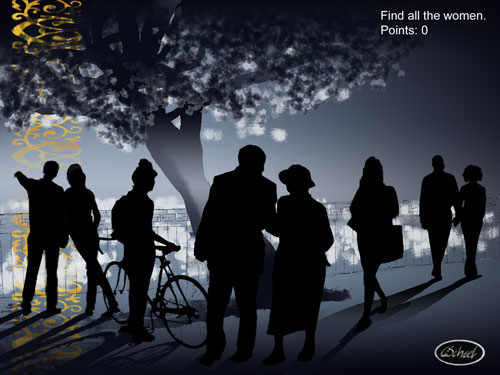
I am a game designer and a special educator, specializing in neuro-education or neuro-rehabilitation. Previous I have experiences working with people with brain injuries. I have created a small basic analysis of the possibilities in Finding things games from a cognitive point of view. Cognitive can be described as the ways the brain functions, here in comparison with Finding things games. There are a large number of variations, but this is supposed to relative basic.
The intension is not diagnostic, since I am a special educator the intension are psycho education, here to learn about ones own functions, practice these functions and perhaps a development of strategies to overcome difficulties. This is not treatment in a medical sense, or in the understanding of cure for a disease, but the much broader term rehabilitation, which include adaptability, learning and reorientation. Finding things games, as well as other types of games can of course also be used by people with normal cognitive functions, to improve their abilities or strategies. This is why difficulties of various kinds are included in the following. Before attempting to describe the cognitive processes involved, an analysis to classify the type of game, so we know what type of game we are dealing with.
Analysis tool for classification of games.
In the following I have created a merge of Christian Elverdam and Espen Aarseths analysis tools for type determination of games, from the article; Game Classification and game design, (Christian Elverdam, 2007)in order to give the reader a general idea of the type of game.
They reach 8 Meta categories: Virtual room, physic room, internal time, external time, player composition, player relations, battle or challenges, and game stage.
Room or virtual room should be considered only to be relevant in regards to computer games, meaning 2D or 3D, but the authors have included chess in their descriptions, so therefore it could be considered as the artificial room of the game or just the game room.
There are some overlaps between this category and the next, when applied to analog games, but I have included them because there are differences.
First they look at, the players perspective, ubiquitous or if the players perspective changes during the game.
Then they look at the players position, if it is dictated completely by the rules of the game or if it is relative, in the sense that the player has options, in regard to the position.
The last part of the virtual room category is to determine if the environment can be effected, dynamic or static, which produces three possible outcomes, it is impossible, the player can make some specific changes or it is free.
The Meta category, The physical room have to similar aspects, perspective and position, the difference is that the determination is based on if the position is chosen by only by the player or if the positions is affected by other players, rules, topography or agents, or if it is a combination of these that determine the position.
The Meta category external time is divided by the representation of time, in imitated real time or if time is arbitrary.
Then it is divided by teleology, meaning the teaching of end goal, expediency or purpose. They distinguish between if the game have a final ending or can go on forever.
The Meta category internal time, speed, distinguish between if real time changes the state of the game or if real time is irrelevant.
Synchronicity, distinguish between if the player can act at the same time or take turns.
Interval control is about whether the players can control the next interval or if the interval is predetermined, or in other words, can the players decide when the next move or turn begins.
The Meta category player composition, how many players are in the game and how are they organized, single player, a team of players, two players, to or more teams of players, a lot of single players.
The Meta category player relations is about the relations between the players, are they static or dynamic, which mean do they change during the game or not.
They distinguish between if, the evaluation of the players is individual, as a team or both.
The Meta category battle or challenges, they distinguish between three different types of challenges, predetermined or variation in a predetermined frame, or determined by another agent, which are considered autonomous
The goal for the players is considered as either absolute or relative.
The Meta category game state is divided into how the game state affects the players and if the gem can be saved. An impact from the game state can either be temporarily, final or infinite.
Then they determine whether the game can be saved, if it is infinite, conditional or if the game cannot be saved.
In the article; A multi Dimensional Typology of games (S.M.Smedstad, 2003) is another description of the game state, here the term control is used, the players position/status is described in detail. The term control, I think is used because the affect is seen as control of the players behavior in the form of rewards of various kinds, such as points or an announcement of the players as the winner of the game. This form of influence is considered to be static. Some games rewards the players by strengthening their avatar, the players character in the game or the players position in the game, is the idea behind the meaning of affect in this regard. By the term power up, is understood that the players acquires artifacts that can be used to strengthening their position, such as swords or likewise. Changes in the character, such as experiences, strength, where the player reaches a new level of experiences are considered permanent.
This description gives me a clearer idea of the influence from the game state onto the players.
In the classifications above I am missing a few things, so I have applied them here:
A short description of the game.
A description of the purpose of the game, internally in the game and externally for the player, the last part is idea of what the player may gain by playing this game.
Classification of a finding things game - shortly.
Since this is not an analysis of one particular game, then it is a general analysis of finding things games in general.
I have chosen just to look at the finding things games, and not games where the game type is a part of a larger game, with different types of game mechanics.
A short general description:
Finding things games, is about finding particular things among others, as a computer game, then the player clicks on the item in order to indicate that the item have been found.
The internal purpose is to find as many right objects as possible, in order to gain as many points as possible.
The external purpose is entertainment; with the possibility of practice visual distinguish ability.
Virtual room;
Often 2D.
The players perspective is ubiquitous.
The Players position is mostly insensitive.
The players control/status can influence the challenges, but they are often insensitive.
Changes of the environment are often not possible, other than collecting points.
Physical room.
Perspective and position are just influenced by the player, if possible.
External time.
Imitates real time.
Teleology ( the teaching of end goal): The games have a final ending.
Internal time.
Internal time is irrelevant for the game, but there could be a time limitation.
Synchronicity: is often irrelevant, since it is often single player games.
Interval control; is mostly controlled by the player.
Player composition:
Single player game, therefore no player relations.
The evaluation of the players is determined individually.
Challenges/ battle; often predetermines, but can be influenced by the players results.
Goals: are final.
Game state:
Reward; points.
Influence: final.
The games can often be saved, often unlimited.
The brain and cognition.
In the field of cognition, the use of different labels for descriptions, varies from one theoretician
to another. I prefer to include a rather large selection of labels, as longs as they describes specific explicit functions, in order to increase the chances of understanding, therefore overlaps will occur. Expressions, on the other hand, that just combines expressions or labels, I do not favor, such as focused visual attention, since I do not see them as explicit, but a combination of different elements. (Gade, 2003, s. 200)
The extremely short version of the basic functions can be seen here:
Vision and Field of vision; the ability to see, to process impressions of vision, as wells as the ability to see all or parts of the field of vision.
Reading comprehension, in order to be able to read an instruction, such as find the yellow things.
Focused attention; the ability to focus ones attention towards a specific task, here to find a specific type of item.
Selective attention; the ability to filter unimportant elements out, as well as keeping focus on others.
Sequential attention, the ability to organize and do tasks in a particular order.
Visual distinguish ability, the ability to distinguish between visual impressions.
Visual acknowledgement and visual recognition, to acknowledge or realize a visual impression, and to be able to recognize what is seen.
The definitions above are based on a number of theoreticians, whom have a set of different way to approach these labels or definitions.
It is primarily Kjeld Fredens, Anders Gade og Mel Levine, as well as the authors of clinical Neurology and Neurosurgery; Klinisk Neurologi og Neurokirurgi. (Fredens, 2004) (Gade, 2003) (Levine, 2005) (Olaf B. Paulson, 2004)
By using a specific designed game to practice or observe, one or multiple specific functions, the functions can be more or less isolated and can, therefore be observed or practiced targeted. The players outcome and learning curve depends mainly on the feedback given to the player.
Most of the activities we do on a daily basis are highly complex and involves a high number of cognitive functions. When designing a game it is possible to reduce the complexity and hereby gain a better focus on each function.
Luckily it is highly unusual for one person to have problems on all areas described below. Often one would have one or some of these, this is why some of the tasks can be difficult for some, but not for others.
Sight and the fields of sight:
The sight itself is what goes on inside the eye, that part is not included here. What I am focusing on is the brains process of the visual impressions.
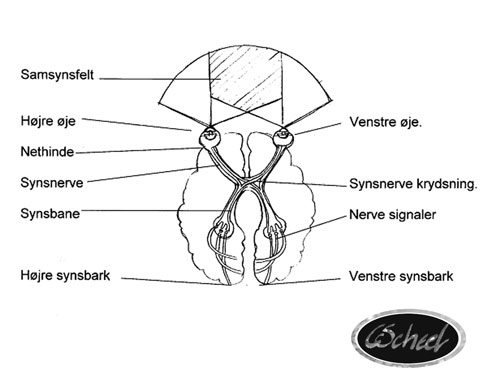
This is a slice of the brain seen from above, with the sight field in front of the eyes, in top of the image.
The shaded area is the field covered by both eyes, when pointed forward. The sight impression is then sent from the eyes, through the brain to the visual cortex. The sight impression from the left eye is being processed in the right visual cortex, and vice versa.
You could call it all the processes in the brain, visual functions. Normally we are able to quickly percept, especially movement, in the entire sight field, regardless of our attentions is directed against at specific area or not. It has been essential for us in order to survive, that we could detect dangers sneaking up on us, at all times. If there is neglect, there are areas of the sight field that the attention is not directed against, which are therefore overlooked.
Neglect is about lacking attention in parts of the sight field and lack of attention towards part of the body, while sight field fall out is about areas of the sight field not being seen. It is not the eye itself that has a problem, but the brains processing of the visual impression, translated into an understanding of the visual impression.
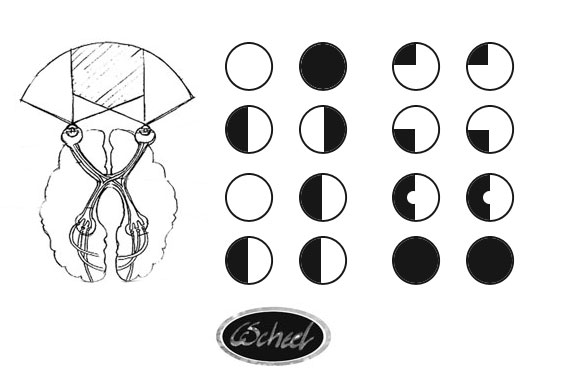
The image above shows sight field fallout. On the left side a slice of the brain is seen from above, on the right two rows of the sight fields. The black areas represents the sight field fall out areas, meaning the areas which visual impressions are not registered from. (Olaf B. Paulson, 2004, s. 29-32)
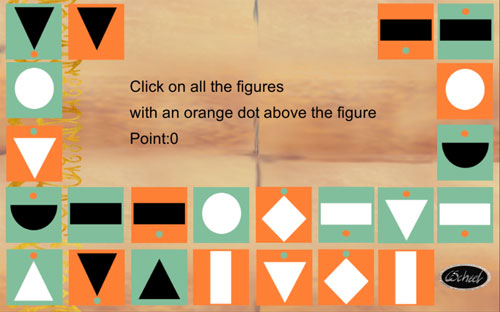
Reading comprehension;
Difficulties understanding what one is reading are called alexia. For example alexia can occur in connection to some types of injuries in the brain, but to understand what one is reading is a relatively complex process including a number of partial elements, including sight and interpretation of the visual impression, just to mention some of them.
Since it requires some skills to understand what one is reading, even if the sentences can be made short and relatively simple, and therefore easier to read, problems in this regard primarily points towards Brocas aphasia. Brocas aphasia is about difficulties expression, while comprehension and therefore also the reading comprehension are light. Aphasia is about language difficulties. Aphasia as a consequence of brain injury, are often followed by difficulties with attention and memory, as well as difficulties finding the right words, in contrast it is not unusual for the affected to be able to point out items, rather than saying the word or writing it. There are of course a much larger number of details i reading comprehension that one could look into, as well as dyslexia can play a part.
Focused attention or concentration;
The definitions varies a bit, some theorists talks about it in terms of the ability to regulate wakefulness, the ability to control if one is awake or not, intentionally. Other theorist also uses focused attention about the ability to focus ones attention on something in particular. This is also described as concentration. We are not talking about motivation, but the ability to do so, the ability o nits own, if one is cabable to focus one attention or concentrate one something.
Kjeld Fredens describes ADHD as difficulties as a complex interaction between attention, motor planning, perception, as well as control and initiative. ADHD will naturally occur while playing a game of finding things. (Fredens, 2004, s. 105)
Selective attention;
The other large basic element is selective attention, meaning the ability to disregard something, while focusing on something specific, as when looking for specific items. This is of course also determine by the player being able to keep an appropriate tempo and do not overlook items because the tempo is too fast, but this is individual and can cariate, also for the individual, depending on one’s concentration.
Both visual distinguish ability and selective attention are continuous for all players, and can change in terms of difficulty.
Depending on how long the player plays and if it is continued over a period of time, then persistent attention can play a part, even though it is typically not involved in a single game or challenge.
Persistent attention means that the attention is focused on something over a period of time; often we talk about persistent attention over a period over time, longer than 15 minutes.
Selective attention is about directing ones attention against something, and disregarding something else, intentionally. Certain parts of the brain functions as a kind of filter, which means that we are able to focus on the essentials, and that we are not equally aware of all things at the same time. Difficulties in this regard can be seen with ADHD. Difficulties in this regard are often described as distraction or easily distracted. It is difficult to keep disturbing elements out of ones attention, while trying to focus on something in particular.
Sequential attention and sequential organization:
Sequential attention is about organizing things in a particular order, including the experience of time. What comes before something else, which day comes before another? We also used the sequential attention when we try to figure out in which order to approach a particular task. It could be getting dressed, for instance it is less practical to get mittens on before scares buttons.
In regards to finding things games, it could mean that you choose to begin in the upper right corner and work your way through the items in an organized manner, instead of exploring the screen at random. (Levine, 2005, s. 182-189)
Visual distinguish ability and spatial organization, as well as visual acknowledgement and recognition;
Overall the games are founded on visual distinguish ability, meaning scanning, analyzing, decoding and interpretation of the visual impression. The visual distinguish ability is a part of visual perception, or the visual understanding.
Visual distinguish ability, is the ability to perceive things visually, and distinguish them from other items. Visual scanning or search is when you visually are looking for something, or in normal words are looking for something, for instance one keys or the milk in a shop. Visual recognition is about recognizing what is seen and connecting it to a term, a name or a label, what we know about the item we are looking for. This includes modules for form, color and movement, as well as their respective perception.
As a consequence of a brain injury the ability for visual recognition can be lost, the sight is normal, but there are no recognition of what is been seen, even for things that are well known. This is called visual agnosia. The understanding of what is seen is lost. There can be a number of reasons for this, according to Anders Gade in his book; Hjerneprocesser, there are to overall reasons, either the ability to connect what is seen with ones knowledge, or the visual impression cannot be gathered into something recognizable. In terms of the last possibility, the visual impression cannot be gathered into something recognizable, the person will often be able to draw an item on request. The knowledge of items and how they look are intact. I the first case it is not possible to connect ones knowledge with the visual impression. (Olaf B. Paulson, 2004, s. 147-149) (Gade, 2003, s. 167-169)
Spatial organization is also about the visual. Spatial refers to space or room, or distance and the relationship between elements. Spatial organization is perceived as wholes, in contrast to sequential organization which are perceived as parts. It is no help for us if we had to perceive a face by processing each element o nits own, eyes, mouth and so on. We sees it all at once, and based on that we can read something as complex as a facial expression, otherwise the facial expression would have changed long before we got through the process of interpretation each element.
Some theorists places the understanding of wholes and part elements under the spatial attention, in which I can see some reason, but I do think that in some contexts the spatial attention are also related or based on language logical abilities, the understanding of concepts, and therefore is different than the spatial organization. Visually or spatial it makes sense to talk about that some parts can be connected or be subordinated others, for instance when it comes to placement. This could be in regards to maps, where some cities belong to a particular region, while others do not.
While it, to me makes more sense in terms of language or concepts to talk about that milk is a dairy product, in contrast to talk about it from at visual point of view. Some of the same things apply to animal species, or the more abstract concepts. The spatial attention or spatial organization also comes into play, when we for instance can feel which object we have in our pocket, without taking it out to take a closer look, we simply knows what object it is, in most cases just by touching it.
Being spatial challenged sometimes are referred to as being space direction challenged, or left right challenged, meaning having difficulties with orientation, having difficulties recognizing visual patterns. If challenged in this regard could also mean that it is difficult to organize one´s belongings, as well as being challenged when searching for items, because the visual template do not function and it is problematic to scan in an organized manner. (Levine, 2005, s. 189-196)
Basically this is what the finding things games are about.
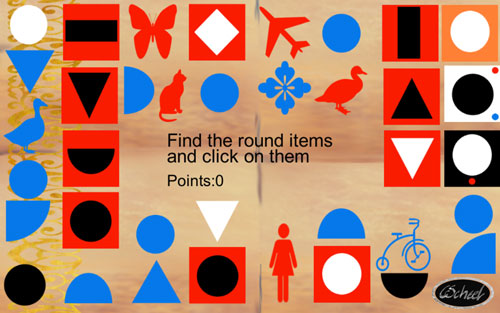
Geometrical figures are relatively easy to distinguish, due to the low level of details, which can make some tasks easier for some players.
Visual depth perception;
Due till the distance between our eyes, we are able to see and perceive depth, even when there are none, such as in images which gives the illusion of depth. Depth perception is based on two things, different sizes of thing, the larger they are, and the closer they are perceived. The other element in depth perception is the lines, the line perspective is based on vanishing points, the place where two or more lines meet called vanishing points.
Visual perceptual organization;
In order to understand how we perceive shape it is important to understand how we visually separate an item from the background, visually. When we see, we generally focus on an item or a gestalt, as a group of psychologists labeled it. We relate or subject aspects which are most likely to be related to the overall item, this is based on our experience, we create patterns, groups or hierarchies.
The gestaltpsycholists formed a number of laws or rules for this organization;
The proximity law;
We have a tendency to group things which are closest to one another, prior to grouping things which are further apart.
The similarity law;
We have a tendency to group thing which look alike, prior to things which are different.
The law about good continuation;
We have a tendency to look at lines as continued even though they may be cut, or broken. This is used by some animals to confuse their enemies, such as zebras, which makes it difficult for the predators to see them clearly.
Closure;
Or ending. We fill out the missing spaces in order to create a whole, even if parts and even if large parts of a figure are missing.
Characteristic detection.
In connection with sight there are a number of cells which amplifies lines and contours, while uniform surfaces are being ignored, or to describe it in a different manner, lines and contours get the most attention, especially lines in movement.
The thickness and the inclination of the lines can also draw some attention, corners and angles may also get attention.
Some sight cells are specialized in attention towards specified sight impression, such as a hand, a face or even more specialized than that. The same goes for words and letter combinations, which probably may be learned.
In this manner the sight works to detect specific characteristic in what we sees, where certain cells are specialized for special tasks.
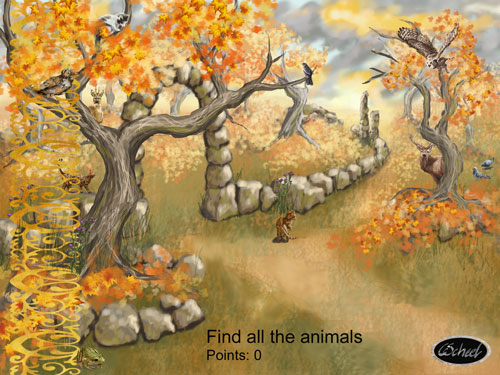
Pattern recognition;
The first step in visual recognition is to isolate the item from the background, after that it becomes at question of object acknowledgement. Object acknowledgement is based on pattern recognition, by comparing information about the objects characteristics with what is being seen. This is not done in detail, but in a fast version where the pattern, in terms of some simplified characteristics for the object is compared with a generalized version of the object, a kind of pattern for the object type.
It could be a chair, the pattern which the specific chair represents, gets compared with the general idea of a chair.
How this precisely are done are yet to be determined, based on the Höffding function, because Höffding questioned if visual perception could be understood as a direct comparison between the visual impression and what is remembered, one of the problems, as he pointed out, is the large variation of different objects and so on. (Gade, 2003, s. 167-182)
Top down and bottom up.
Top down and bottom up, is about the strategy that we uses when we analyses or scan the items.
Top down mean that we begin with the overall impressions and then goes into details, we may begin with a hypothesis in regards to how things looks and then examine it in details.
Bottom up means beginning with the details, and from there work our way towards an overall hypothesis about, for instance what type of object it is.
Colors;
The colors do play a part i how we distinguish and perceive different figures, as well as in which emotions and associations they bring forward. Colorblindness and color weakness plays a part in how difficult the player experiences the challenge, as well as color tones, saturation and light intensity, even if the color perception is normal. The eye has specialized cells for color perception, like other sight impressions.
Motor skills and eye hand coordination;
In terms of pointing and clicking we will typically consider the use of a touch screen or to point and click using a mouse. Both demands motor skills, as well as eye hand coordination, but to point and click using a mouse, until the process is automated a complex process. Når vi taler om at pege og klikke på en skærm vil vi i dag typisk enten tale om en touch skærm eller at pege og klikke via musen. However since this is not the focus of the analysis I have chosen just to mention it.
To summen things up:
Eventhough finding things games at first sight looks relatively simple, there are a lot possibilies to invovle and direct the game type toward specific cognitive functions, as well as the process is more complex than it may appear. apart from that comes varition in levels of difficulties, for whom.
Bibliografi
Christian Elverdam, E. A. (2007, january). Game Clssification and game design. games and culture, Vol2 R, sage Publications .
Fredens, K. (2004). Mennesket i hjernen. Århus: Systime academic.
Gade, A. (2003). Hjerneporcesser, kognition og neurovidenskab. Frydenlund.
http://www.almensprogforstaaelse.dk. (2016). Retrieved from http://www.almensprogforstaaelse.dk/downloads/billedsprog.pdf
https://www.hjernesagen.dk. (2012). Retrieved from https://www.hjernesagen.dk/media/264063/Afasi-og-kommunikation-dias.pdf
Levine, M. (2005). Hjernen bag lysten til at lære-neuropædagogik i teori og praksis. Denmark: dansk Psykologisk forlag.
M.J. Riddoch, G. H. (1987). To see but not to see. A case study of visual agnosia. London: Lawrence Erlbaum.
Olaf B. Paulson, F. G. (2004). Klinisk neurologi og neurokirugi. Århus: Foreningen af Danske lægestuderendes forlag.
S.M.Smedstad, L. E. (2003). DiGRA. Retrieved december 10, 2016, from www.digra.org: http://www.digra.org/digital-library/publications/a-multidimensional-typology-of-games/